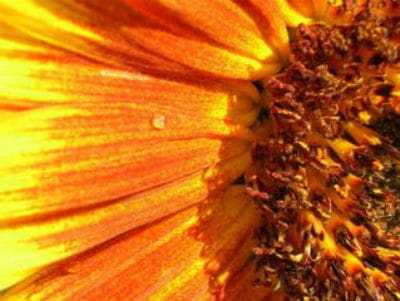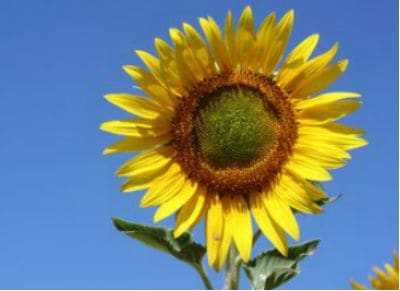Growing and Harvesting Sunflowers

No summer garden looks complete without majestic sunflowers towering over the other crops, their signature yellow petals facing the sun. Certainly, sunflowers are a summertime favorite, lending cheer to harvest landscapes throughout the growing season. In addition to their beauty, sunflowers are a source of food, as well as ingredients for herbal medicine and natural cosmetics. They are easy to grow in almost any type of soil and their seeds are simple to harvest with versatile uses.
History of the Sunflower
The sunflower is indigenous to the Americas, with the Native Americans being the first to take advantage of its many uses.
Medicinally, Native Americans used the sunflower to treat pulmonary infections, such as pleurisy, bronchitis, and pneumonia. In addition to bird food, sunflower seeds were also roasted and made into a tea.
After the New World was discovered in 1492, specimens of the newly discovered sunflower were brought back to Europe. The earliest record of sunflowers was published in 1568 by a Belgian herbalist.
After they made their way across Europe, sunflowers were introduced to Russia and China, where its fibrous stems have been utilized for manufacturing fabrics and paper.
In laboratories around the world, the insides of the sunflower stalk- the pith- are examined as one of the lightest substances in the world. In the Netherlands, farmers plant sunflowers in soggy soil because of their amazing ability to absorb water.
Uses for the Sunflower
Food
As most of us know, sunflower seeds are great for snacking on the go and are an excellent source of good fat, vitamins, and protein. They can be consumed raw, roasted, or dried.

In Native American history, Indians would ground the seeds for flour which was used for baking.
Even sunflower petals are edible. Try cooking and eating them like artichokes.
Of course, people are not the only ones who enjoy snacking on sunflower seeds. They are a source of food for animals, especially birds.
Cosmetics
Sunflower oil is a popular ingredient in many natural soaps, potions, and candles. The properties found in sunflower oil have been known to treat many skin conditions.
Medicine
Sunflower roots are a popular ingredient in some herbal medicines and remedies which may be used to treat spider and snake bites. They can also be ground into a tea to treat fevers and stomach ailments.
Growing Sunflowers
Given their beauty and many uses, it is no surprise that many gardeners incorporate sunflowers into their summer gardens. There are nearly 70 different types of sunflowers, ranging from 1 to 15 feet in height with a variety of colors.
They are resilient flowers and can thrive in almost any type of soil, although they do best in slightly acidic or sandy soil. Since they are Native to the arid American prairies, they can even survive droughts, once they get established.
Planting
Some gardeners start sunflower seeds indoors before the first frost, but it is not usually necessary. Even in climates with short growing seasons, sunflowers can be planted 1 to 2 weeks before the fist frost without the seeds being damaged.
For long growing seasons, try waiting until the soil reaches 55 to 60 degrees and sow them directly into the ground.
Space the seeds 6 inches apart in rows that are 2 inches deep. Keep them well watered for the first 7 to 10 days, until they sprout.

When the sunflowers start growing their second set of leaves, they can be thinned out to only 2 feet apart to ensure their roots have plenty of room to spread out.
Growing Time
Different varieties of sunflowers will have different maturation times. Typically, they mature between 80 to 120 days. Try sowing different varieties with different growing times, or plant the sunflowers in rounds, to ensure continuous blooms throughout the growing season.
Caring for Sunflowers
As their name implies, sunflowers need a lot of sunshine. Make sure they have a spot in the garden that gets between 6 to 8 hours of full sun each day. They flourish during the long, hot summers.
Sunflowers have long roots and are heavy feeders, so try adding organic fertilizer or compost to the soil before planting for an extra boost.
Some varieties of sunflowers can grow very tall – up to 15 feet! To protect them from strong or damaging winds, consider planting these tall varieties along a fence row or against a building. Even planting next to corn can help stabilizing them.
However, some very tall sunflowers will need some extra support, such as a bamboo stake. Simply tie the bamboo to the sunflower stalk with a twine, securing it every 3 to 5 inches, starting near the base of the stalk.
Harvesting Sunflower Seeds
Harvest sunflower seeds is a very simple process.
First, make sure the sunflower head is spent. When they are ready to harvest, they will be brown and drooping toward the ground. If they still have yellow petals and are facing the sun, it is not time to harvest seeds yet.

Using a knife or pruning tool, cut the sunflower stalk 4 to 6 inches from the head. Using a spoon, or by hand, scrape the seeds out of the center and into a bucket. Other debris will be scraped out in the process. Be sure to separate the seeds from the debris before cooking or roasting.
Soak the seeds in water and salt overnight. Use 1 cup of salt for every gallon of water. Sunflower seeds can be eaten raw, but many prefer them roasted.
To roast sunflower seeds, preheat the oven to 350 degrees Fahrenheit and place the un-shelled seeds on a baking sheet. Roast them in the oven for 30 to 40 minutes. Once they have cooled, store them in an airtight container.
Conclusion
Sunflowers are easy to grow and make lovely additions to summer garden landscapes across the country each summer. Consider growing a variety of sunflowers, ranging in height and harvesting the seeds for snacks, birdseed, tea, or sunflower seed oil and enjoy the aesthetic and practical contributions of America’s favorite beauty!
